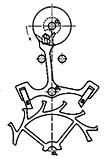
 PRECISION WATCH REPAIR BY CHARLIE SQUIRES
PRECISION WATCH REPAIR BY CHARLIE SQUIRES
| Question:
Question: What does the term "complication" mean and how does it differ from "grand complication"? James W. Clee, Bruges, Belgium
By convention, a watch is said to be "simple" when it indicates hours, minutes and seconds. Following this definition, a watch equipped with an automatic mechanical movement, indicating only these functions, would also be considered a "simple" watch. The same definition applies for a very precise chronometer which indicates the time with a very high degree of accuracy, even though this particular timepiece has been subjected to a series of very stringent tests by the Chronometric Observatory or another official chronometric testing facility. While sometimes people confuse a chronometer and a chronograph, these two timekeepers are not at all the same. Chronographs are defined below. A watch is said to be "complicated" when it indicates functions in addition to the time. These may include optical readings using hands or windows, or they may be acoustical in nature, using chimes or bells A "grand complication"is a watch that contains at least three "complications", coming from each of the groups listed below. Group 1: Complications using visual indications a. Simple chronograph
Group 2: Complications using visual astronomical indications f. Simple calendar
Group 3: Complications using acoustical indications j. Alarm
Definitions of complications by group Group 1 a. A simple chronograph is a watch possessing a center sweep second hand which can be started, stopped and brought back to zero by means of a push-button.
b. A counter chronograph has one or two additional subdials which count the minutes or hours starting from a given point in time.
c. A split-second flyback chronograph is equipped with two superimposed center sweep second hands which can be started together. The flyback hand may then be stopped to indicate the reading at an intermediate time. When it is restarted, this hand instantaneously "flies" back to the position of the first hand. d. The independent second hand chronograph was the precursor of the modern chronograph. It consisted of an independent center or sweep second hand which could be started or stopped independently of the normal time function but which could not be reset to zero. This second hand advanced instantaneously then remained immobile for nearly a second until it advanced again. It was driven by a wheel and an independent spring which was wound separately by turning the crown backwards. These watches have not been produced for many years but are now highly prized by collectors. e. The jumping second hand chronographused an independent center sweep second hand which advanced continuously rather than in jerks. In addition, this watch contained a small hand in a special subdial at 6 o'clock which completed a revolution in one second, jumping around in four or five successive quick movements. This timepiece is no longer being made. Group 2 Astronomical functions were the first complications to be introduced into watches. As early as the 16th Century, many years before the regulating spiral was invented, exquisite pocket watches were equipped with date readings and lunar phases. f. Simple calendar watches provide one, two or three functions, i.e. the date, often the day and sometimes the month. All the months have 31 days so it is necessary to manually correct the watch five times per year. g. Perpetual calendar time-pieces provide the three indications of their simple calendar cousins but also automatically correct for the 30-day months as well as for February's 28 or 29 days.
h. The indicator for moon phases is made up of a small specially shaped window in which the various phases of the moon appear and disappear month by month. The most common mechanism in use today is composed of a single wheel with 59 teeth supporting two symmetrical moons. The wheel moves by one tooth per day which gives a lunation of 291/2 days. Since the true lunation is 29 days, 12 hours, 44 minutes and 2.8 seconds, this gives a difference of 44 minutes and 2.8 seconds per lunation, or an advance of one day over a period of 2 years and 235 days. i. The time equationfunction indicates the difference between the true local solar time and the average artificial time. Our 24-hour day is an artificially designated average solar day. The true solar time varies constantly in relation to the average solar time, with the difference reaching more than 14 minutes around February 11 and 16 minutes around November 3. Only four days per year are actually exactly 24 hours long. If a person wants to set his watch using a sun dial, it is necessary to know this time difference, or time equation, for each day of the year. In the past, some watches were equipped with a fixed hand indicating the time equation at noon each day. Other watches used an additional minute hand carrying a sun which continuously showed the local true solar time. Although no longer considered very useful, the time equation watches are highly regarded by collectors. Group 3 j. The alarm function uses a very old mechanism whose fabrication was a mandatory part of the training for master watchmakers. This acoustical device can be programmed for a period of 12 or 24 hours. The term repeater is used for a watch equipped with a strike or chime capable of indicating the hour on demand and repeating it as often as desired. The precision of the time indicated depends on the type of repeater. k. A quarter repeater function strikes, on demand, the hours and quarter hours which have just passed. It uses two bells of different tones, signaling each hour by a low tone and each quarter hour by a higher tone followed by the lower one. For example, at 3:40, the quarter repeater strikes three low tones, followed by two series of high-then-low tones, giving bong, bong, bong, silence, then bing-bong, bing-bong. By mentally adding 71 1/2 minutes to the hour chimed, the largest deviation between the real time and the last hour chimed will be 71 1/2 minutes (one-half of a quarter-hour). In our example of 3:40, we can estimate the time to be 3:37.5, giving an error of 2.5 minutes.
l. A half-quarter repeater function strikes the hours and the quarter-hours but uses a high tone to signal that the half-quarter has just passed. Using our example of 3:40, this repeater would chime as follows: bong, bong, bong, silence, then bing-bong, bing-bong, then bing to indicate that a half-quarter has just passed.
m. A five-minute repeater system strikes the hours with a low tone and each five-minute interval with a higher tone. At 3:40, the mechanism would chime bong, bong, bong, silence, then eight higher pitched bings. n. A minute repeater watch strikes the hours and quarters as does a quarter-repeater. In addition, the minutes which exceed the last quarter are signaled by a succession of rapid strikes on the higher toned bell. For example, 12:59 would be given by 12 low tones, then three series of high-low tones, followed by 14 rapid high tones. o. Watches with a passing strike function automatically signal the hours and quarter-hours, with the hour repeated at each quarter. They also are equipped with a device indicat-ing the hours and minutes on demand. The energy for this function is provided by a powerful spring which is wound at the same time as the watch. However, the number of demands is limited. A silence position is also provided to discontinue the chime, if desired. Grand complications It is possible to make several types of grand complications. In general, though, they are composed of a split-second flyback chronograph with counters combined with a perpetual calendar (with or without moon phases) and a repeater function, usually a minute repeater. There is, however, nothing to prevent the addition of other elements not mentioned here, such as a power-reserve indicator, thermometer, hygrometer or any other device not yet imagined by today's watch-making geniuses.
Question Is it possible to attribute the creation and development of the first perpetual calendar watch to a specific watchmaker? Ralph Edgar, Portland, Maine, USA
Most watch historians give credit for this invention to Abraham-Louis Breguet (1747-1823). Indeed, Breguet was a great watchmaker, having invented and perfected a large number of ingenious devices. However, in an article entitled "Horology" published in 1765 in the Encyclopedia by Diderot and d'Alembert, there is a description of a watch equipped with a perpetual calendar using a large disk on which are marked the months and dates of a normal year. But this timepiece was made by a Swiss watchmaker working in Paris named Ferdinand Berthoud (1727-1807). The disk made a revolution in 365 days and the month of February contained 28 days. It was therefore necessary to let the watch stop on February 29 in order to maintain the time equation function which was also part of Berthoud's system. The energy for his perpetual calendar was derived from the daily winding of the watch. Another watchmaker also preceded Breguet in the development of the perpetual calendar function. Jean-Antoine LÚpine (1720-1814) was known as the inventor of various devices which Breguet then later perfected. One example, among others, is the anti-shock device which is often mistakenly credited to Breguet. LÚpine also invented calibers for bridged watches. His ingenious system replaced the upper plate and simplified assembly and the development of functions. It is still used in all mechanical watches today. Regarding the perpetual calendar, one of LÚpine's biographers wrote: "In 1770, LÚpine had the honor of presenting to Louis XV an astronomical repeater watch equipped with a time equation function and perpetual calendar. The former was used only in clocks and the latter was his own invention." Unfortunately, the watch in question has disappeared and no other perpetual calendar timepiece is known to have been made by him. Breguet may have picked up this invention later, since, as some historians speculate, he may have been a student of LÚpine. |
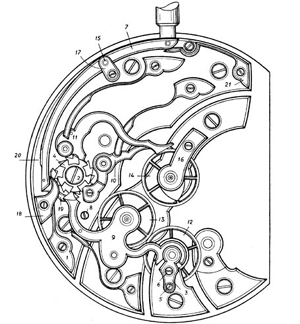
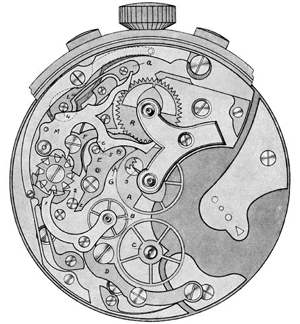
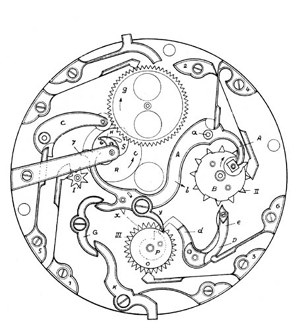
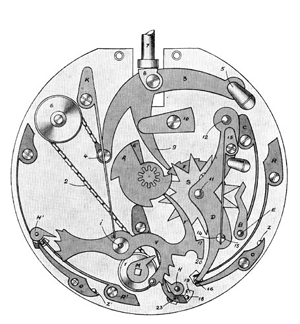
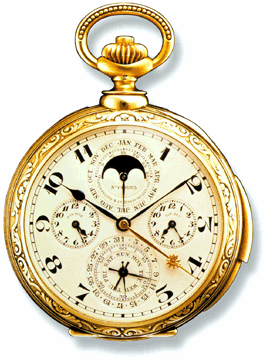 Patek Philippe pocket watch for James
Ward Packard with a perpetual calendar, solar hour, rising and setting sun times, moon
phases and a rotating disk of 500 stars representing the Ohio night sky, minute repeater
with three bells.
Patek Philippe pocket watch for James
Ward Packard with a perpetual calendar, solar hour, rising and setting sun times, moon
phases and a rotating disk of 500 stars representing the Ohio night sky, minute repeater
with three bells.